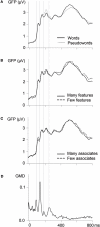The time course of semantic richness effects in visual word recognition
- PMID: 22347855
- PMCID: PMC3278705
- DOI: 10.3389/fnhum.2012.00011
The time course of semantic richness effects in visual word recognition
Abstract
The richness of semantic representations associated with individual words has emerged as an important variable in reading. In the present study we contrasted different measures of semantic richness and explored the time course of their influences during visual word processing as reflected in event-related brain potentials (ERPs). ERPs were recorded while participants performed a lexical decision task on visually presented words and pseudowords. For word stimuli, we orthogonally manipulated two frequently employed measures of semantic richness: the number of semantic features generated in feature-listing tasks and the number of associates based on free association norms. We did not find any influence of the number of associates. In contrast, the number of semantic features modulated ERP amplitudes at central sites starting at about 190 ms, as well as during the later N400 component over centro-parietal regions (300-500 ms). Thus, initial access to semantic representations of single words is fast and word meaning continues to modulate processing later on during reading.
Keywords: ERPs; N400; semantic richness; visual word recognition; word meaning.
Figures



Similar articles
-
The time course of semantic ambiguity in visual word recognition: behavioral and ERP evidence for the lexical-semantic effect.Front Psychol. 2024 Jul 9;15:1378125. doi: 10.3389/fpsyg.2024.1378125. eCollection 2024. Front Psychol. 2024. PMID: 39045435 Free PMC article.
-
ERP manifestations of processing printed words at different psycholinguistic levels: time course and scalp distribution.J Cogn Neurosci. 1999 May;11(3):235-60. doi: 10.1162/089892999563373. J Cogn Neurosci. 1999. PMID: 10402254
-
N400 effects of semantic richness can be modulated by task demands.Neuropsychology. 2017 Mar;31(3):277-291. doi: 10.1037/neu0000327. Epub 2016 Nov 3. Neuropsychology. 2017. PMID: 27808538
-
Compounding matters: Event-related potential evidence for early semantic access to compound words.Cognition. 2019 Mar;184:44-52. doi: 10.1016/j.cognition.2018.12.006. Epub 2018 Dec 14. Cognition. 2019. PMID: 30557749
-
Language-Related ERPs: Scalp Distributions and Modulation by Word Type and Semantic Priming.J Cogn Neurosci. 1994 Summer;6(3):233-55. doi: 10.1162/jocn.1994.6.3.233. J Cogn Neurosci. 1994. PMID: 23964974
Cited by
-
A predictive coding model of the N400.Cognition. 2024 May;246:105755. doi: 10.1016/j.cognition.2024.105755. Epub 2024 Feb 29. Cognition. 2024. PMID: 38428168 Free PMC article.
-
Metaphors are physical and abstract: ERPs to metaphorically modified nouns resemble ERPs to abstract language.Front Hum Neurosci. 2015 Feb 10;9:28. doi: 10.3389/fnhum.2015.00028. eCollection 2015. Front Hum Neurosci. 2015. PMID: 25713520 Free PMC article.
-
The posterior semantic asymmetry (PSA): specific to written not auditory semantic word processing.Exp Brain Res. 2018 Dec;236(12):3327-3340. doi: 10.1007/s00221-018-5379-z. Epub 2018 Sep 25. Exp Brain Res. 2018. PMID: 30255197
-
No matter how: Top-down effects of verbal and semantic category knowledge on early visual perception.Cogn Affect Behav Neurosci. 2019 Aug;19(4):859-876. doi: 10.3758/s13415-018-00679-8. Cogn Affect Behav Neurosci. 2019. PMID: 30607831
-
The Effect of Sweet Taste on Romantic Semantic Processing: An ERP Study.Front Psychol. 2019 Jul 9;10:1573. doi: 10.3389/fpsyg.2019.01573. eCollection 2019. Front Psychol. 2019. PMID: 31354580 Free PMC article.
References
-
- Balota D. A., Yap M. J., Cortese M. J., Hutchison K. A., Kessler B., Loftis B., Neely J. H., Nelson D. L., Simpson G. B., Treiman R. (2007). The English Lexicon Project. Behav. Res. Methods 39, 445–459 - PubMed
LinkOut - more resources
Full Text Sources

